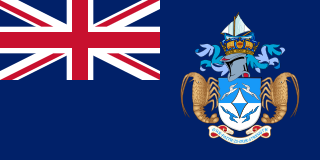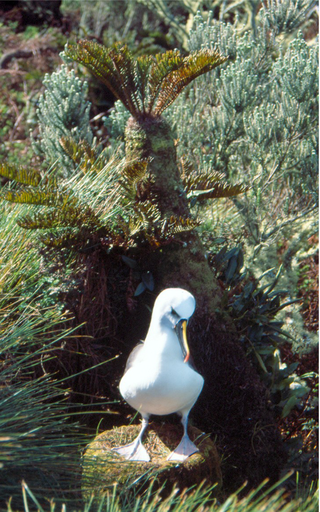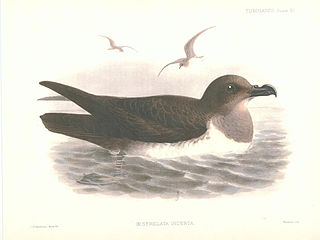
Tristan da Cunha, colloquially Tristan, is a remote group of volcanic islands in the South Atlantic Ocean. It is the most remote inhabited archipelago in the world, lying approximately 2,787 kilometres (1,732 mi) from Cape Town in South Africa, 2,437 kilometres (1,514 mi) from Saint Helena, 3,949 kilometres (2,454 mi) from Mar del Plata in Argentina, and 4,002 kilometres (2,487 mi) from the Falkland Islands.

The thrushes are a passerine bird family, Turdidae, with a worldwide distribution. The family was once much larger before biologists reclassified the former subfamily Saxicolinae, which includes the chats and European robins, as Old World flycatchers. Thrushes are small to medium-sized ground living birds that feed on insects, other invertebrates and fruit. Some unrelated species around the world have been named after thrushes due to their similarity to birds in this family.

The Inaccessible Island rail is a small bird of the rail family, Rallidae. Endemic to Inaccessible Island in the Tristan Archipelago in the isolated south Atlantic, it is the smallest extant flightless bird in the world. The species was formally described by physician Percy Lowe in 1923 but had first come to the attention of scientists 50 years earlier. The Inaccessible Island rail's taxonomic affinities and origin were a long-standing mystery; in 2018 its closest relative was identified as the South American dot-winged crake, and it was decided that both species are best classified in the genus Laterallus.

Gough Island, also known historically as Gonçalo Álvares, is a rugged volcanic island in the South Atlantic Ocean. It is a dependency of Tristan da Cunha and part of the British overseas territory of Saint Helena, Ascension and Tristan da Cunha. It is approximately 400 km (250 mi) south-east of the Tristan da Cunha archipelago, 2,400 km (1,500 mi) north-east from South Georgia Island, 2,700 km (1,700 mi) west from Cape Town, and over 3,200 km (2,000 mi) from the nearest point of South America.

Inaccessible Island is a volcanic island located in the South Atlantic Ocean, 31 km (19 mi) south-west of Tristan da Cunha. Its highest point, Swale's Fell, reaches 581 m (1,906 ft), and the island is 12.65 km2 (4.88 sq mi) in area. The volcano was last active six million years ago and is now extinct.

Nightingale Island is an active volcanic island in the South Atlantic Ocean, 3 square kilometres (1.2 sq mi) in area, part of the Tristan da Cunha group of islands. They are administered by the United Kingdom as part of the overseas territory of Saint Helena, Ascension and Tristan da Cunha.

The spectacled petrel is a rare seabird that nests only on the high western plateau of Inaccessible Island in the South Atlantic Tristan da Cunha group. It is one of the largest petrels that nests in burrows. This species was formerly considered to be a subspecies of the white-chinned petrel.

The Nightingale Islands are a group of three islands in the South Atlantic Ocean, part of the Tristan da Cunha territory. They consist of Nightingale Island, Middle Island and Stoltenhoff Island. The islands are administered by the United Kingdom as part of the overseas territory of Saint Helena, Ascension and Tristan da Cunha. The Nightingale Islands are uninhabited.

The Atlantic yellow-nosed albatross is a large seabird in the albatross family Diomedeidae.

Stoltenhoff Island is a small uninhabited island in the South Atlantic Ocean, part of the Nightingale Islands. It is the smallest of the Nightingale Islands, and is to the northwest of Nightingale Island itself. They are governed as part of Tristan da Cunha, an archipelago and part of the British overseas territory of Saint Helena, Ascension and Tristan da Cunha. The island is part of the Nightingale Islands group Important Bird Area (IBA), identified as such by BirdLife International as a breeding site for seabirds and endemic landbirds.

The Atlantic petrel is a gadfly petrel endemic to the South Atlantic Ocean. It breeds in enormous colonies on Tristan da Cunha and Gough Island, and ranges at sea from Brazil to Namibia, with most records at sea being to the west of the breeding islands, and along the subtropical convergence. Adults are about 43 cm long, powerful, large, stocky, dark in color with white belly. Their head can appear to be grey in worn plumage. Brown undercoating of wings and tail. These petrels can live on average of 15 years of age.
Saint Helena, Ascension Island and Tristan da Cunha, as well the other uninhabited islands nearby, are a haven for wildlife in the middle of the Atlantic Ocean. The islands are or were home to much endemic flora and fauna, especially invertebrates, and many endemic fish species are found in the reef ecosystems off the islands. The islands have been identified by BirdLife International as Important Bird Areas for both their endemic landbirds and breeding seabirds.

The grey petrel, also called the brown petrel, pediunker or grey shearwater is a species of seabird in the Procellariidae, or petrel family. It is pelagic and occurs in the open seas of the Southern Hemisphere, mainly between 32°S and 58°S.

The Ecuadorian thrush is a resident bird found in western South America in western Ecuador and far northwestern Peru. It was formerly considered to be a subspecies of the spectacled thrush, Turdus nudigenis, but has a narrower eyering, and is widely separated in range.

The northern rockhopper penguin, Moseley's rockhopper penguin, or Moseley's penguin is a penguin species native to the southern Indian and Atlantic Oceans. It is described as distinct from the southern rockhopper penguin.

Tristan da Cunha is an archipelago of five islands in the southern Atlantic Ocean, the largest of which is the island of Tristan da Cunha itself and the second-largest, the remote bird haven, Gough Island. It forms part of a wider territory called Saint Helena, Ascension and Tristan da Cunha which includes Saint Helena and Ascension Island.

The Tristan da Cunha–Gough Islands shrub and grasslands is a terrestrial ecoregion which covers the Tristan da Cunha archipelago and Gough Island in the South Atlantic Ocean. The islands' remote location gave rise to many endemic species.














